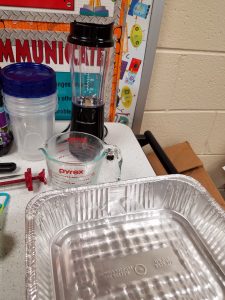Today’s fun experiment in the STEM Lab: making homemade gummy worms! Once I heard about this activity, I could not wait to try it out. It’s fairly easy, and requires only a few ingredients. Like the homemade bouncy ball lesson, this activity also deals with polymers, but this time they are edible.
Supplies
- Juice (I used apple and grape)
- Syringe (I used ‘flavor injector’ syringes from the cooking aisle with the needle part removed)
- Sodium Alginate
- Calcium Chloride
- Blender
- Small storage containers
- Handheld strainer
- Glass or aluminum baking tray
- Teaspoon
- Measuring cup
Most of these items you probably have lying around, or can be purchased cheaply at a WalMart or grocery store. The only items that may be tricky to find are the sodium alginate and the calcium chloride. Thankfully, these can be easily and inexpensively ordered from Amazon.
First step – the juice mixture! I recommend doing this ahead of time because it needs an hour or so to ‘set’. In your blender combine 1 cup of juice with 1 tsp sodium alginate and blend well. Sodium alginate is a gelling agent. The mixture will immediately start to thicken up and become very foamy. Decant the mixture into a storage container and let it sit for an hour or more for the bubbles to dissipate. I put my containers in the fridge during this time.
Once your mixture is ready, add several inches of water to your baking dish, and mix in a teaspoon or two of calcium chloride. Add a few inches of just water to a second baking dish for rinsing the worms when they are done. Use the syringe to pull up some of your juice mixture, and slowly squirt it into the water and calcium chloride mixture. The calcium chloride solution will react with the sodium alginate to make the mixture gel up into the gummy worms.
Use the strainer to scoop out the finished worms, and rinse them in the plain water pan. Now comes the best part: eat your gummy worms! I recommend storing uneaten worms in the fridge.
This lab is a fun, edible way to learn about chemistry!
Your gummy worms are an example of a polymer, a large molecule made of repeating units. The sodium alginate in the squirt bottle is made of short polymer molecules that can easily slide around each other inside the water. The calcium ions in the bowl cross-link these short polymers together into longer strands turning the stream of liquid from the squirt bottle into a thick gel.
Source: http://www.sciencenter.org/chemistry/d/activity_guide_gummy_worms.pdf




















